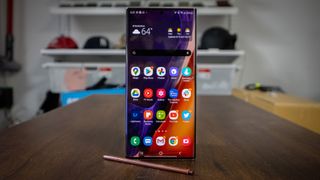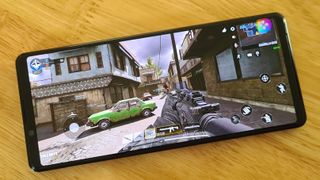How to buy the right Android phone for you
The smartphone world is a big and scary place – here’s how to navigate it

Choosing a new smartphone is more difficult now than it’s ever been. However, if you’re reading this then you’ve likely made the first decision – iPhone or Android – already. Congratulations.
Android smartphones are the best they’ve ever been, serving up incredible screens, powerful innards, class-leading cameras, swanky software tricks, and much more. There’s never been a better time to nab yourself a shiny new Google-powered handset, especially since mid-range offerings with superb specs and performance can be yours for less than ever before.
The downside, however, is the fact that there are literally hundreds of Android options out there, coming from a plethora of manufacturers, all vying for your attention.
That’s where we come in. We’ve already rounded up a list of the best Android phones you can buy today, which should make your final decision easier. But before you head on over with your wallet in hand, let’s slow down a little. How do you use your current phone? What are you looking for? What will you be doing over the next few years?
We pose these questions to you because we all have different needs. Some of us love taking and sharing photos, while others may prefer whiling away hours flossing in Fortnite. Not only that, but the world is a pretty crazy place right now, and we’re all spending more time at home. The huge battery that may have once topped your list of priorities may be less important today, especially when you throw ultra-fast charging into the mix. But we’re getting ahead of ourselves.
Here’s everything you need to think about before choosing the perfect Android phone for you:
1. What’s your budget?

The amount of money you’re prepared to drop on a smartphone is the number one thing you need to decide upon before going any further.
Get daily insight, inspiration and deals in your inbox
Get the hottest deals available in your inbox plus news, reviews, opinion, analysis and more from the TechRadar team.
As with most things in life, you get what you pay for. For example, splurging out just over a grand will net you a powerhouse such as the feature-packed Samsung Galaxy Note 20 Ultra. It may win you over with its flagship specs, multi-cam setup, and the do-it-all S Pen for note-taking, productivity and doodling, but do you really need all that functionality?
If you’re a productivity fiend and/or an artist then, yes, it may be worth the cash. But if you’re unlikely to ever make use of that S Pen stylus, then it doesn’t make sense to spend more money than you need to.
On the flipside, if you’re after a simple, reliable handset that can capture decent pictures, will see you through a day and can handle pretty much any task then it’s absolutely worth considering a mid-range handset such as the OnePlus Nord, which comes close to offering flagship performance at a very reasonable price.
2. Are you a shutterbug?
Let’s get interactive. Grab your current smartphone, open up the gallery, and begin scrolling. What do you see? Selfies? Cats? Food? Buildings? More cats? Not much at all?
There’s no right or wrong answer, but this is an excellent way to determine just how much you use your camera, and how important it is to you. If you see a bunch of selfies or even group selfies, then maybe front-facing cameras should command more attention when you’re choosing your next phone. Some even offer ultra-wide selfie cams so you can easily fit large groups into shots.
If you take a lot of shots at night time, then you’ll want to keep an eye out for cameras with dedicated night modes and/or larger sensors and solid low-light performance. In general, the best-performing low-light smartphones tend to be the most expensive, since the shooting conditions demand the best lenses, sensors and algorithms.
For those who mainly capture images in the daytime, your choice is wider; pretty much any mid-range to flagship device you pick from a major brand will likely take excellent shots in bright conditions.
3. How much power do you need?

There was a time when your phone would slow to a crawl a year or so after purchase, suffering frequent crashes, reboots – with you uttering many a swear word as a result. Thanks to advances in processor technology, coupled with a general raising of specs across the board, even most mid-range handsets today will provide more than enough power for most people.
In fact, we’d go as far as to say that unless you’re an enthusiast pining for the latest and greatest specs, or a hardcore mobile gamer who’s constantly running super-demanding games such as Call of Duty: Mobile, you won’t need powerful processors such as Qualcomm’s Snapdragon 865 5G.
Mid-range processors such as the Snapdragon 765 coupled with around 8GB of RAM will blitz through apps, media and multitasking without issue. Unless you’re specifically after a handset with which you can play heavy-duty games or process 8K video a la the Galaxy S20 range, raw specs is one area where mid-range Android phones really shine.
4. How much will you use it?
At the time of writing, most of us aren’t travelling nor commuting to the degree we were pre-pandemic. Which brings us neatly to our next consideration: battery life.
Not too long ago, heavy phone users with long commutes would often get caught out with their devices issuing low battery warnings whilst having their after-work pint. Anxiety over whether a smartphone will last the day is a real issue, which is the reason battery life is one of the most important attributes for most people.
While you might not be out on the town as much now, you’re likely using your phone more than ever, scrolling through your Insta feed or numbing your mind with TikTok cats in a bid to keep those spreadsheets and PowerPoint documents at bay a little while longer.
Thankfully, modern smartphones are more efficient at sipping power, and battery capacity has also improved. Beyond the fact that you’re more likely to be at home with a charger to hand, one of the biggest developments to look out for is the speed at which a smartphone charges.
For example, the OnePlus 8 Pro can reach 50% capacity in just 30 minutes thanks to its Warp Charge 30T charger, which is an impressive feat given its 4,510mAh battery. With companies such as Samsung and Xiaomi also offering their own versions of fast charging, range anxiety will soon become a thing of the past.
5. Screen time

There are a few features worth mentioning that may hold different levels of importance to some people, and the first of these is the screen. Beyond choosing one that’s a comfortable size for your hands, also worth considering are the display type itself and the resolution.
AMOLED displays are widely regarded to offer the best experience, thanks to their true blacks, amazing contrast, and rich, punchy colors. The best screens around also offer higher refresh rates, with 120Hz currently being the spec to beat.
In our opinion, a 120Hz screen is a nice bonus. However, in reality you’re unlikely to be able to determine the difference between that and a 90Hz – or even perhaps 60Hz display – unless you’re wearing your scrutinizing hat.
Take note of the resolution, too. If you’re an avid movie watcher/videographer then you could opt for a 4K-toting handset such as the Sony Xperia 1 II, but you’ll be paying extra for the privilege. QHD resolution is the de facto for all flagships – but if we’re being completely honest, 1080p, or Full HD, is totally fine for most people.
If you’re a money-no-object buyer, then you have the luxury of potentially selecting a handset with a folding screen. As an early adopter, you’ll be paying a huge premium, but the looks of amazement of people’s faces when you unfold phones such as the Samsung Galaxy Z Fold 2 or Motorola Razr, will (potentially) be well worth it.
6. Hit the road jack
A somewhat controversial feature (or lack, thereof) is the headphone jack. Most people are now used to the fact that almost every single new phone now comes minus this feature. But if you’re adventurous enough to traverse online to Android enthusiast forums, you’ll discover a lot of outraged posts about this brave new jack-less world.
Their argument is, in this writer’s opinion, a solid one. Headphone jacks offer the most flexibility for listening to music or watching videos, since you can use them with any of your existing headphones. Not only that, but you’re always prepared if you come across speakers with AUX inputs.
While Bluetooth headphones have come on a long way, we still have occasional problems with audio lag and connection interference, not to mention they’re just another gadget you need to remember to charge. And while USB-C headphones exist, it means you can’t charge your phone at the same time.
We’d rather headphone jacks remained with us – but, sadly, it appears their time is nigh. At the time of writing, the best phones that still carry headphone jacks include the Google Pixel 4a, the LG V60 and the Samsung Galaxy S10 Plus. So, if you’re an audiophile who’s looking to continue using their trusty cans, it’s something to bear in mind.
7. The speed of 5G

Ridiculous corona conspiracy theories aside, the 5G network coverage is growing, with every major carrier offering the service in selected locations.
The benefits are, of course, much faster speeds. However, you’ll only be able to take advantage if coverage exists in your area – which, at the moment, is pretty unlikely. Still, if you’re in a 5G area and willing to pay a little extra per month for the privilege, then we won’t discourage you – just bear in mind that you’ll be paying a premium for a 5G handset.
If you’re unlikely to be in a 5G area very often then we’d advise that you hold off; by the time you upgrade your phone, the technology and level of coverage will be more mature. Having said that, the majority of new flagships come with 5G as standard, so that’s some extra future-proofing to take into consideration.
Esat Dedezade is a freelance writer, journalist, and content creator. After six years as a staff writer and deputy features editor at Stuff, he left to pursue a new challenge at Microsoft, where he was the editor of their European news centre for three years.
Esat experience enabled him to write about and review consumer tech and lifestyle, in addition to corporate/agency copywriting, and thought leadership pieces for large companies.

